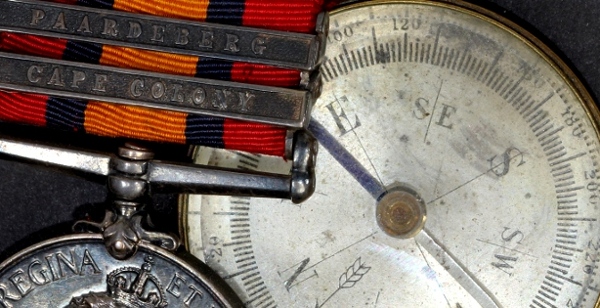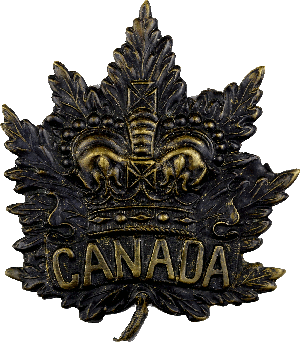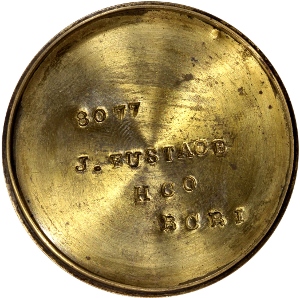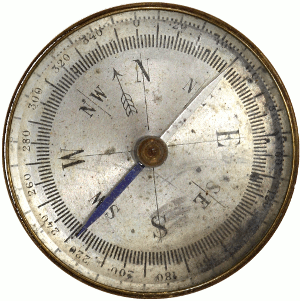Topic: Paardeberg

The Paardeberg Compass
 A soldier's medals are an interesting connection of the soldier to his (or her) period of service. Medals might be for a specific campaign, placing the soldier in time and place, they could be long service awards, for valour or meritorious service, or for commemorative purposes. Some medals show hard evidence of years of wear on parades, dutifully polished until finer details are removed, or even until most details are obliterated through that pride of service and a heavy polishing technique.
A soldier's medals are an interesting connection of the soldier to his (or her) period of service. Medals might be for a specific campaign, placing the soldier in time and place, they could be long service awards, for valour or meritorious service, or for commemorative purposes. Some medals show hard evidence of years of wear on parades, dutifully polished until finer details are removed, or even until most details are obliterated through that pride of service and a heavy polishing technique.
Medals, however, lack one connection to the service they represent. They are invariably issued after the fact, and could not have been with the soldier during the events that saw them earned. For that connection, we must seek other artifacts, ones we can be reasonably certain were in a soldiers backpack, or pockets, or even in hand on the field of battle or in an operational area. Such items can be difficult to attribute with confidence unless they are received from the soldier with provenance. But occasionally we do discover just such a piece of memorabilia.
One such is the pocket compass of 8077 Colour-Sergeant John David Fox Eustace.


Colour-Sergeant (now we would know him as a Company Sergeant Major) Eustace was a Militia soldier serving in Halifax with the 63rd Regiment, Halifax Rifles, at the outbreak of the South African War (Boer War). Eustace, like many of his country-men from coast to coast, volunteered to serve with a battalion of infantry raised as Canada's First Contingent to South Africa. This battalion was the 2nd (Special Service) Battalion, The Royal Canadian Regiment.
While The Royal Canadian Regiment continued to garrison its four Company stations in Fredericton, St Jean, Toronto and London, it also provided 84 officers Non-Commissioned officers and soldiers for this new battalion. the remaining 921 members of the Battalion came, almost completely, from over 100 units of the Canadian Militia from across the country. John Eustace was one of those Militia soldiers, and he served as the Colour-Sergeant of “H” Company, which was raised in Nova Scotia.
Colour-Sergeant Eustace enlisted at Halifax on 20 Oct 1899 at the age of 30. An immigrant born in Dublin, Ireland, Eustace was serving in the 63rd Regiment (Halifax Rifles) at Halifax when he volunteered for service in South Africa. A single man, he was employed as a grocer in his civilian life. His service record describes him as five feet, six inches in height, 140 lb, with a 36-38 inch chest, fair complexion, dark brown hair and blue eyes. He was assessed as having good muscular development, good intelligence, a sanguine temperament. fair complexion, hearing and feet good and, finally, heart, lungs, hernia; all normal.
Eustace served with The Royal Canadian Regiment in South Africa until he was invalided to England on 13 Aug 1900. His discharge followed not long after, with his Certificate of Discharge dated 31 Aug 1900, reading:
“This Certifies that No. 8077 Colour Sergt. J.D.F. Eustace of Halifax in the County of Halifax, Province of Nova Scotia, Dominion of Canada, aged 31 years, served continuously in H Coy, 2nd Battn., The R.C.R., S.S. Force of Active Militia of Canada, from the 20th day of October 1899 to the 31st day of August 1900 and is now discharged therefrom.”
Signed BH. Vidal, Lt. Col., D.O.C. 8.
Eustace was eligible for the Queen's South Africa Medal with two clasps: Cape Colony and Paardeberg. In late 1903, Eustace's medal was sent to the South African Constabulary, with which unit he was then serving, having returned to South Africa. (Eustace's QSA is known to have survived, location unconfirmed.)
John Eustace's company was in the front lines of the assault at the Battle of Paardeberg on 27 February 1900, the first major British victory over a Boer force. In this action, which saw the surrender of General Cronje, the contribution of the Canadians was celebrated throughout the Empire.
While we are certain John Eustace's medals could not have been at Paardeberg, we can be reasonably certain that he had his pocket compass with him.
![]()
So, how do we determine that a man who served many years before South Africa, and again afterwards, carried this compass at Paardeberg?
Eustace's compass is marked, stamped inside the brass cover, with the following details:
- 8077
- J. Eustace
- H Co
- RCRI
John Eustace only held the regimental number “8077” while he served with the 2nd (Special Service) battalion of The Royal Canadian Regiment. Similarly, he was only in “H” Company of that unit for his service in South Africa. And the “RCRI”? For a brief period, between 1 April 1899 and 1 November 1901, The Royal Canadian Regiment was officially known as “ The Royal Canadian Regiment of Infantry.”
Imagine, a Colour-Sergeant (Company Sergeant Major) on the open veldt of South Africa, as his company approaches occupied Boer trenches in the darkness before the dawn of 27 February 1900. Did he use this compass to help keep direction as the distance to the enemy closed? How many years afterwards did he carry it, a constant reminder of his service in South Africa as a Royal Canadian?

